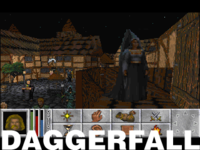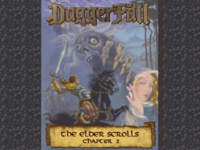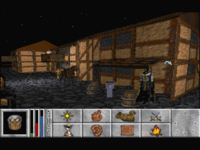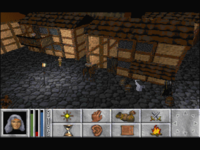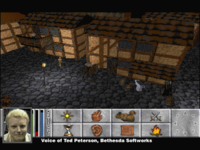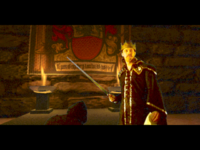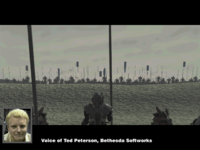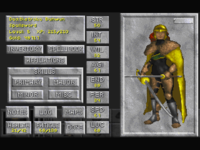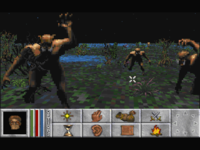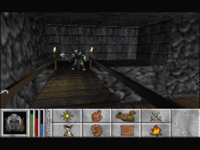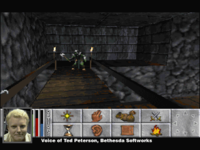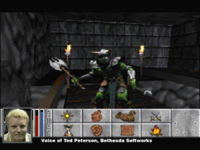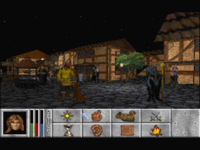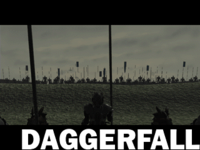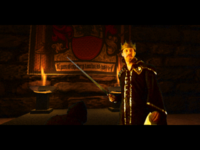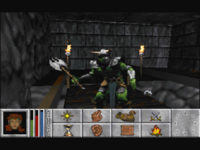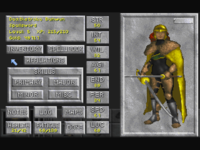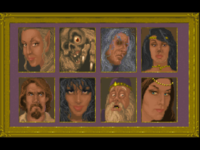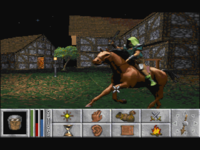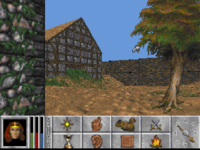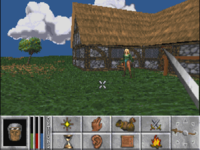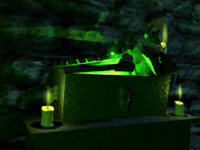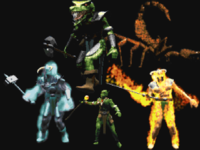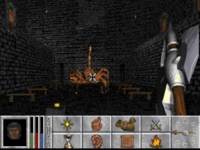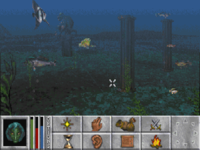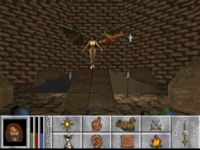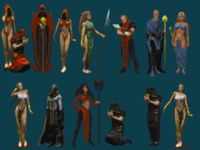Daggerfall:Interactive Entertainment Previews
Interactive Entertainment, or simply IE, was a multimedia magazine distributed on CD-ROM containing reviews, previews, demos, and patches for video games.
Daggerfall was previewed in IE on two occasions in 1995. Each preview had an audio version, which played over a slideshow of prerelease images, and a text version which covered mostly the same information but with entirely different wording. Both audio previews were presented by Gregory T. Henry. Also included were the expected PC hardware requirements, which changed over time. IE ceased publication before Daggerfall released so there was no review.
Episode 11[edit]
IE episode 11 was released in March 1995. Developer Ted Peterson was interviewed and clips of him are included in the audio preview. Undersea exploration is emphasized as a major feature and the way the faction system is described does not match the final game. A CD-ROM drive is listed as merely "recommended," suggesting that a floppy disk version was planned at this stage. The game's release is said to be "only a couple of months away" but it would ultimately come out over a year later.
Audio Preview[edit]
After setting the standard for first-person RPGs with Elder Scrolls: Arena, Bethesda Softworks has a tough task ahead of them in creating a worthy sequel. From what we’ve seen and heard, though, Daggerfall will be everything its predecessor was and more. Ted Peterson, the game’s chief producer, spoke about the enhancements and additions which will make the second Elder Scrolls game stand out in the cluttered RPG crowd.
Daggerfall still uses a first-person 3D engine but the world of Tamriel has been made even more realistic thanks to improved texture mapping and more emphasis on topography.
- Ted Peterson: "The engine itself is totally different from the one that was in Arena. It’s a fully contoured landscape, you know, where everything from mountain peaks to swimming through the ocean to climbing down into the bottom of the ocean— exploring shipwrecks and whatnot."
In the tradition of a true roleplaying game, Daggerfall gives complete control to the player and shies away from linear progression. Your character has a number of career options ranging from guild training to political campaigning. And there is a main quest.
- Ted Peterson: "You are given an assignment at the beginning of the game from the Emperor, basically to investigate and quell a potential uprising in the court of Daggerfall, which is one of the city-states from the original Arena game, and you are sent that region which is where all these political factions are basically battling for control. And the Emperor has his own agenda and again, like any other group, there are positive and negative things that can be said about that, and you can choose to stand against him, you can choose to fight for him on the side of law and order but, you know, there’s things to be said for both."
Creating your character will be a very detailed and precise process. In addition to offering traditional character classes such as warrior and rogue, Daggerfall actually lets you create your own classes. Here we see a male and female Spellword. [sic]
One thing’s for sure, monsters don’t care what class you are! Arena boasted a huge number of creepy crawlies, and Daggerfall boasts even more. Some of these things are so twisted they can make Doom’s creatures look tame. From the looks of these guys, I’d advise you to stay out of the swamps.
Since travel, conversation, and combat are all real-time in Daggerfall, one has to wonder how easy it’ll be for the player to handle everything at once without going insane.
- Ted Peterson: "What I understand from talking to different reviewers and people on the boards is that one of the things they liked most about Arena is how easy it was to move throughout the world; it was pretty intuitive. And we’ve kept all of that, you know, and of course the challenge of creating a more complicated game while keeping it as simple as Arena as far as just moving around, intuitive, that’s been, you know, one of the major things that we’ve been trying to accomplish."
As an added bonus for veteran Arena players, Bethesda has kept Arena’s character creation system for Daggerfall and old, wizened Arena characters can be converted for play with the new game. Time to buy a copy of Arena if you haven’t already; it’s the best thing you can do to prepare yourself for Daggerfall. It won’t be long now.
Bethesda is preparing to shake up the RPG world once again with the release of the second game in the Elder Scrolls series. Daggerfall, due out some time in the first quarter of this year, will be the most dynamic RPG ever for the PC. Supplementing the superb texture-mapped 3D interface of Arena with new political and economical elements previously unseen in roleplaying games. Hold your breath and get ready.
Text Preview[edit]
We are (hopefully) nearing the end of what may be the longest-running and most popular era in computer gaming history: the first-person era. Wolfenstein, Doom, and their many spin-offs are the hottest commodities around now, and many software developers outside the action/arcade genre have taken notice of that. Witness the massive acceptance of first-person perspectives in roleplaying games. All of the major players in the RPG wars (SSI, Sir-Tech, Origin, etc.) have released at least one first-person game, and collectively, have plans for many more. They've been hitting the shelves at a rather rapid rate, and keeping up with all the new releases is getting difficult. I doubt that Bethesda's next Elder Scrolls game will slip by me, though. It looks way too good to miss.
Elder Scrolls: Daggerfall (Or just Daggerfall, as it will likely be known) is the sequel to Arena, Bethesda's first RPG release. Arena gained instant popularity among hard-core roleplayers for its breathtaking graphics and incredible character depth. As is the norm with sequels, Daggerfall basically one-ups its predecessor in every aspect . . . improving old features and adding new ones previously unseen in PC RPGs. One old feature of special importance in Arena was the SpellMaker, a revolutionary system which enabled spellcasters to concoct their own spells by combining various magical effects. SpellMaker gave Arena a reputation for being overly biased toward magicians . . . personally, I found those allegations to be completely true, but I've always favored playing wizards anyhow, so it was all the better. Daggerfall's version of the SpellMaker is improved slightly and allows for the creation of potions and items in addition to spells.
Other new things to look for in Daggerfall include a revamping of the 3D interface which drew such praise in Arena. The new interface is fully 3-dimensional and allows the player to jump, crawl, climb, duck, look up and down, and basically perform any vital function. New texture-mapping and a greater emphasis on topography make Daggerfall's scenery look more like the real thing. Among the many kinds of locales to explore are caves, castles, suboceania, subterrainia [sic], and even alternate dimensions. In each location, the player will have opportunities to interact with (not just "listen to") a plethora of non-player characters. Conversation, like everything else in Daggerfall, is very true to the real thing. Your responses and actions have a realistic effect on the outcome of the discussion.
Perhaps the most interesting new feature in Daggerfall is the incorporation of political conflict. Details are still sketchy at this point, but from what we've heard, the plot will go something like this: The Emperor of Tamriel asks your character to do him a favor and quell a potential uprising in the royal court of Daggerfall. Unlike other RPGs, which would stem various other quests off of that main quest, Daggerfall's quests are all independent, so you need not fulfill the Emperor's request. If you don't, you'll be given a number of other adventuring opportunities from the many political factions which seek your services. In essence, you can win the game by joining one of the factions and bringing it to power. To do this, you must buy, sell, and trade with the other factions (you can even commit criminal acts, such as smuggling and thievery). If you prefer to wander and just take the occasional quest as it presents itself, fine. You can play that way, too. Daggerfall is unmatched in its variety.
Other aspects of the game, such as combat and character creation, are basically unchanged, and exist in Daggerfall the same way they did in Arena. To preserve the fluidity of the all-in-one 3D interface, combat takes place in real-time, which can be difficult for newcomers to get used to (it was for me). If you're any good at Doom, though, your reaction time should be sufficient to handle whatever Daggerfall throws at you. Whaddya think? A first-person perspective to treat the eyes . . . an outstanding roleplaying system to satisfy hard core RPG fanatics . . . political and trading elements to entertain strategy lovers . . . it sounds too good to be true. It's not. It's only a couple of months away . . .
System Requirements[edit]
IBM PC and compatibles
Minimum: 486-33, 8MB RAM, joystick or MS compatible mouse
Recommended: CD-ROM drive
Supported: Aria, Ensoniq, Roland, SB, Gravis soundcards
Episode 19[edit]
IE episode 19 was released in November 1995. Daggerfall is the featured game for this episode, with the Underking appearing on the case and throughout the menus. The cut features of being able to hire underlings and having the option to automate conversations are brought up, as well as a deeper system for communicating with enemies in a dungeon, and many potential character disadvantages are listed which would not make it to the release version. A CD-ROM drive has been moved to the minimum requirements by this point but the minimum CPU frequency is still lower than in the final system requirements. Otherwise, this preview is more accurate to the Daggerfall that released, even giving a correct estimate of the number of dungeons.
Audio Preview[edit]
Have you ever run into that awkward equation in computer games where in order to get great graphics gameplay has to somehow suffer, or vice-versa? Well Bethesda Software [sic] is about to prove that you can have your cake and eat it, too. The sequel to the highly acclaimed RPG The Elder Scrolls: Arena is called Daggerfall and from all reports it’s the most intricately designed fantasy roleplaying game the market has ever seen.
As the game begins. The player is summoned by the Emperor to perform a special mission. The royal court of Daggerfall is experiencing great turmoil and if it’s in your power you are requested to help stop a potential uprising. Make no mistake, this is the main adventure of the game, but you still do not have to say yes. If you’d rather, you can just explore the enormous terrain, talk to the folks you meet, and back away at monsters to your heart’s content. There are over four thousand dungeon areas to delve into.
You can import your favorite Arena characters into Daggerfall, but you’ll definitely want to try out the new game’s character construction system. Instead of rolling virtual dice, you answer a series of questions about the sort of character you want, in effect discussing your idea with the computer, and the program will generate your character from the answers you give. Daggerfall also uses a GURPS-style disadvantage system. You get enhanced attributes by taking on disadvantages like nearsightedness, or an obnoxious personality, or having no legs. Admittedly, wheelchair technology is not very advanced in the Kingdom of Daggerfall, but the choice is there.
Many supposedly throwaway aspects of character creation suddenly become meaningful in Daggerfall. Before this, no one has really given much thought to the issue of language in a computer RPG. In Daggerfall there is a common language that can be used but it may be a better choice to use the local lingo and get on the natives’ good side. Of course, there is always the possibility of misphrasing your sentences and getting into deep trouble. Or at the very least, coming across like a moron. And then there’s the matter of clothing. Yes, your character’s choice of outfit will affect reactions and this is reflected in the game.
The dialog system in Daggerfall is not just a series of expanding menus and sentences to choose. While that aspect does exist, the player can also choose their general attitude towards someone from the beginning. You can even pick a desired outcome from a conversation and let the computer choose the sentences that will take you there.
Character relations continue to have deep and lasting effects long after an encounter ends. If you treat your underlings well, the word will get around and you’ll gain a modicum of respect before people even meet you. Of course, being too nice might make troublemakers think you can be pushed around. And the reverse is also true, being overbearing and threatening your staff may keep potential assailants away, but everyone else will avoid you, too. There’s even the possibility of talking to a group of Orcs in a dungeon rather than just hacking away on sight. If the conversation goes well it’ll improve your relations with Orcs from then on.
But ultimately you’re going to have to fight something and there’s no lack of truly vicious and dangerous adversaries to hack into. There’s also an online bestiary that lets the player find out what he’s dealing with when face-to-face with a new foe. There are many new monsters in Daggerfall as well as new weapons and spells. The SpellMaker utility has also been upgraded, allowing for all kinds of eldritch possibilities.
The world of Daggerfall, as mentioned before, is really huge. Whether or not you choose the Emperor’s quest, you will explore beautifully designed caves, castles, dwellings, highlands, and lowlands. To accomplish some tasks you may even need to travel underwater. This is not recommended if you don’t have much magic backing you up. All of the navigation is accomplished with a powerful 3D engine that can operate in either VGA or SVGA, depending on your system’s power.
Not everything in Daggerfall is intended for all ages. Rather than create a game with a young audience in mind, the designers opted to implement a lockout feature called ChildGuard. This password program lets parents control how much violence, language, and sexual content little Bobby is exposed to. But, whatever your age, if you’re a roleplaying enthusiast, Daggerfall is bound to be a must-have when it hits shelves this Christmas. If you’re not a roleplaying enthusiast, this could be the game that turns you into one.
The Elder Scrolls: Daggerfall is the sequel Bethesda’s Arena and continues that game’s mold-breaking roleplaying tradition. The emphasis is very much on character development, interaction, and freedom of choice rather than hack-and-slash combat. The intricate gameplay is combined with a fast and powerful 3D engine and breathtaking environments.
Text Preview[edit]
Many fantasy role-playing games for the computer are structurally based, to at least some degree, on Advanced Dungeons and Dragons, the infamous "D&D" that sends concerned parents and fundamentalists into a righteous tizzy. The player constructs characters based on randomized statistics, forms a party and charges into dark, evil surroundings, looking for monsters to kill and loot to plunder. Sure there's usually a nearby town, and non-player characters to talk to, but that's all window dressing, right? The real show is down in the dungeon, right?
Well, Bethesda Software has already challenged these assumptions with the first chapter of The Elder Scrolls: Arena. The player's flexibility of play increased dramatically, and much more attention was paid to character interaction than to combat: in short, actual role-playing was involved! But if you thought that was impressive, you'd better brace yourself for the sequel, Daggerfall. Instead of following the D&D model, this game adheres closely to the infinitely more flexible GURPS system.
Even starting with the character construction system, Daggerfall breaks away from the pack. Instead of rolling virtual dice to generate scores, the player essentially has a "conversation" with the program about what sort of character is desirable, and, bang, there he or she is. This system also allows the player to take on GURPS-style Disadvantages, ranging from paranoia to intensely unpleasant body odor to loss of a limb, for enhanced statistics. This can make for a much better-rounded character, and in this game, such subtleties can actually make for a noticeable difference in gameplay. Even such an apparently throwaway detail as character clothing can actually affect the game. An attractively built woman will be treated differently if she is wearing an expensive high-cut gown than if she chooses a scale-mail bikini. Vallejo-ly mackerel!
Character interactions can have tremendous variation and surprisingly subtle consequences. If you generally behave well toward the people around you (like your hirelings, for example), the word will get around and you will gain a positive reputation that will precede you and help your dealings with other people. By the same token, if you behave like a superior jerkwad, it could seriously turn folks off and make it harder to negotiate.
Incidentally, negotiation isn't just for the tavern anymore. Some humanoid dungeon-dwelling races, like orcs and goblins, are intelligent enough to hold a conversation. If, instead of hacking and slashing away when you first encounter these critters, you try talking to them, it could positively impact your dealings with that race for the rest of the game. Even the conversation structure itself has been turned on its ear. While you can just go through the chat choosing sentence after sentence, you can also pick an ultimate objective for a conversation, and let the computer get you there.
The flexibility inherent in this game can be downright boggling. At the start of the game, the player is asked to undertake a special mission on behalf of the Emperor to quell a potential uprising in the royal court of Daggerfall. That's not so amazing. The amazing thing is... YOU CAN SAY NO! If you choose not to take this path, it doesn't end the game. You can find other paths to explore in this world. (In fact, there's about 4000 adventuring locations in the game!) And if you do choose to investigate the court, it's ultimately up to you which side to defend.
Have no fear, the visual side of Daggerfall lives up to all its many gameplay possibilities. The game features Bethesda's X(n)gine, a powerful 3D engine that lets the player maneuver smoothly across the topographical landscape in VGA or SVGA, depending on the system's power. The extremely variable terrain includes caves, castles, dwellings, highlands, and lowlands, and even allows the player to travel underwater.
If you had a favorite character from your Arena game, you can import it into Daggerfall and continue your adventures. You can also use the SpellMaker utility for new magical power, although there's even more mystical potential in this new chapter. There are lots of new monsters, new spells, and an enormous landscape to explore. The themes of some of the quests and encounters may occasionally range into the "mature" range, so Daggerfall comes with the ChildGuard lockout feature, to ease the minds of those concerned parents I was talking about before. Could this be the RPG to end all RPGs? Doubtful, because then Bethesda would have no reason to do another sequel!
System Requirements[edit]
IBM PC and compatibles
Minimum: 486/33, DOS 5.0, 8MB RAM, double-speed CD ROM, VGA graphics card
Peripheral support: Joystick
Sound support: Aria, Ensoniq, Roland, SoundBlaster, and UltraSound
External Links[edit]
Interactive Entertainment magazine archive
IE Episode 11 audio preview on YouTube
